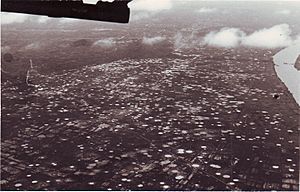Vietnamese Demilitarized Zone facts for kids
The Vietnamese Demilitarized Zone (DMZ) was a special area in Vietnam. It was created to divide North Vietnam and South Vietnam. This division lasted from July 22, 1954, to July 2, 1976.
The DMZ was meant to be a temporary border. It was set up after the First Indochina War. But during the Vietnam War (1955–1975), it became a very important battle line. It separated the communist North from the anti-communist South. The DMZ officially ended when Vietnam became one country again in 1976.
Where Was the Vietnamese DMZ?
The border between North and South Vietnam was about 76 kilometers (47.3 miles) long. It stretched from west to east in what is now Quang Tri province. It started near Laos in the west. Then it went east to a village called Bo Ho Su.
From there, the border followed the Ben Hai River. The river flowed northeast out to the Gulf of Tonkin. On both sides of this line, there was a Demilitarized Zone. This zone was like a buffer, about 6 to 10 kilometers (4 to 6 miles) wide. Even though it was called the "17th parallel," the border didn't exactly follow that line. It was just in the general area.
A Brief History of the DMZ

The First Indochina War was fought in a region once called "Indochina." This war lasted from 1946 to 1954. It was between the French Union and the communist-led Viet Minh. The Viet Minh won the war in May 1954.
After the war, an agreement was signed in Geneva on July 22, 1954. This agreement ended French control over Vietnam. Vietnam was then divided into two parts. The northern part became the Democratic Republic of Vietnam, or North Vietnam. It was led by the communist leader Ho Chi Minh.
The southern part became the independent State of Vietnam. Later, it was called the Republic of Vietnam, or South Vietnam. This part was led by Ngo Dinh Diem. A temporary border was set up along the Ben Hai River. The area around this border was declared a demilitarized zone. No soldiers from either side were allowed there.
However, a new war broke out between North and South Vietnam in 1955. This was the start of the Vietnam War. The DMZ became a real international border. The Vietnam War also became a "proxy conflict" of the Cold War. This means bigger countries supported one side or the other without fighting directly.
Millions of American soldiers and their allies came to help South Vietnam. They fought against communist North Vietnam from 1965 to 1973. Even though the DMZ was supposed to be neutral, many soldiers were present there. In January 1968, it was estimated that over 40,000 North Vietnamese and Viet Cong troops were in the DMZ area.
North Vietnam eventually won the war. The government of South Vietnam fell on April 30, 1975. The DMZ officially ended when North and South Vietnam reunited on July 2, 1976. The country became one communist nation.
Images for kids
See also
 In Spanish: Zona desmilitarizada de Vietnam para niños
In Spanish: Zona desmilitarizada de Vietnam para niños
- 1st Searchlight Battery (United States)
- Clear Path International - an American NGO assisting victims of bombs and landmines left over from the Vietnam War in Central Vietnam
- Demilitarized zone
- Hien Luong Bridge
- Korean Demilitarized Zone
- McNamara Line
- Inner German border and Berlin Wall





